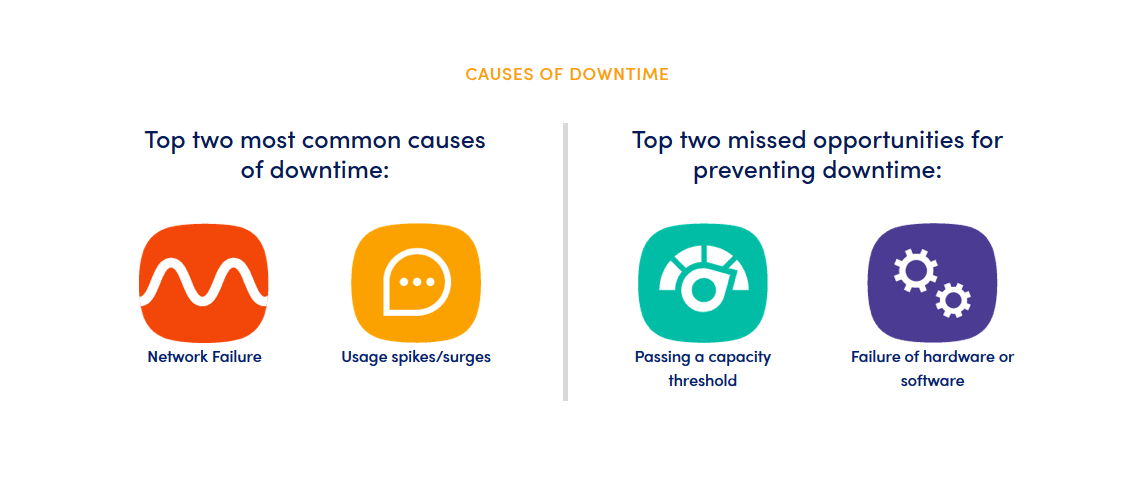
(Updated: 08-02-2024)
As businesses continue to embrace digital transformation, availability has become a company’s most valuable commodity. Availability refers to the state of when an organization’s IT infrastructure, which is critical to operating a successful business, is functioning properly. However, when an organization experiences an influx in demand or another catastrophic IT issue, availability subsides and downtime occurs at an alarming rate. One of the biggest challenges organizations face is that availability is difficult to maintain and is indiscriminate, even for the world’s largest enterprises.
Companies like British Airways, Facebook and Twitter have all battled through expensive outages in recent years that not only impact their businesses, but also expose society’s growing dependence on technology to perform key functions of our daily needs. As technology continues to advance, IT outages will continue to ensue and will affect more than just an organization’s bottom line.
Downtime is still a major issue
Outages occur when an organization’s services or systems are unavailable, while brownouts are when an organization’s services remain available but are not operating at an optimal level. According to a LogicMonitor survey of IT decision-makers in the US, Canada, UK, Australia and New Zealand, 96 percent of respondents said they experienced at least one outage in the past three years.
An average of 50 percent of respondents in the US, Canada and UK said they experienced five or more outages in the past three years. Approximately 50 percent of US, Canada and UK respondents said they had experienced four or fewer outages in the same timeframe.
Preventing IT downtime is crucial for maintaining productivity and ensuring smooth operations within an organization.
Here are the 10 ways to help minimize and prevent IT downtime:
- Regular System Maintenance: Implement a proactive maintenance schedule for servers, networks, and hardware to identify and address potential issues before they escalate.
- Redundancy and Backup: Set up redundant systems, hardware, and data backups to provide failover options in case of hardware or software failures.
- Monitoring and Alerts: Utilize monitoring tools to continuously track system performance and receive real-time alerts when potential issues arise.
- Patch Management: Stay up-to-date with software patches and security updates to mitigate vulnerabilities and reduce the risk of system failures.
- Load Balancing: Distribute network traffic across multiple servers to ensure even workloads and avoid overloading any single system.
- Disaster Recovery Plan: Create a comprehensive disaster recovery plan that outlines the steps to be taken in the event of a major system failure or data loss.
- Testing and Simulation: Regularly test disaster recovery procedures and simulate potential failure scenarios to validate the effectiveness of the recovery plan.
- Employee Training: Educate employees about IT best practices, such as avoiding suspicious links and attachments, to reduce the risk of cyber-attacks that can lead to downtime.
- Vendor Support and Maintenance Contracts: Ensure that critical systems have active support and maintenance contracts with vendors to receive timely assistance in case of issues.
- Continuous Improvement and Documentation: Regularly review and update IT policies and procedures based on lessons learned from past incidents, and document them to facilitate consistent practices.
Remember, no system is entirely immune to downtime, but by following these preventive measures and having a robust disaster recovery plan, you can significantly reduce the impact of potential IT downtime on your organization.

An outage can impact more than just an organization’s finances. The survey found organizations that experienced frequent outages and brownouts incurred higher costs – up to 16-times more than companies who had fewer instances of downtime. Beyond the financial impact, these organizations had to double the size of their teams to troubleshoot problems, and it still took them twice as long on average to resolve them.
The industries most affected
Results from the survey also revealed that the frequency of outages and brownouts is conducive to the industry in which the company operates. Financial and technology organizations experienced outages and brownouts most frequently during a three year period, followed by retail and manufacturing. According to the survey:
- 41 percent of respondents from financial organizations stated that they experienced 10 or more outages over the past three years.
- 37 percent of respondents from technology organizations said they experienced 10 or more outages over the past three years.
- 34 percent of respondents from retail organizations stated that they experienced 10 or more outages over the past three years.
- 28 percent of respondents from manufacturing organizations stated that they experienced 10 or more outages over the past three years.
These numbers highlight the sweeping nature of outages across the various industry sectors and prove that no company should consider itself immune.
The importance of availability
Availability matters not only to an organization’s customers, but also to the IT decision-makers tasked with maintaining it. In fact, 80 percent of global respondents indicated that performance and availability are important issues, ranking above security and cost-effectiveness. After all, IT availability is essential in the smooth running of IT infrastructure and therefore crucial to maintaining business operations. Availability ensures that airline passengers, for example, aren’t stranded due to system outages, food stays at safe temperatures and customers can access their online banking applications.
Despite the importance of availability, IT decision-makers indicated that 51 percent of outages and 53 percent of brownouts are avoidable. This means that organizations could prevent this costly downtime, but do not have the means necessary – whether that involves tools, teams or other resources – to avoid it.
Concerns over the repercussions
With high-profile outages and brownouts hitting the headlines on a regular basis, concerns over the repercussions of experiencing downtime are inevitable. In the US and Canada, 50 percent of respondents said they will likely experience a major brownout or outage so severe that it will generate media attention. Of the same respondents, 52 percent fear someone will lose his or her job.
The sector that feared the repercussions of downtime the most was retail, followed by manufacturing. 68 percent of respondents working in retail felt that they would experience a major brownout or outage so severe that it would make national media coverage and that someone could lose his or her job. 67 percent of IT decision-makers in manufacturing felt it would make national coverage, while 69 percent were concerned someone would lose his or her job.
Comprehensive monitoring is key
To combat downtime, it’s critical that companies have a comprehensive monitoring platform that allows them to view their IT infrastructure through a single glass panel. This means potential causes of downtime are more easily identified and resolved before they can negatively impact the business. This type of visibility is invaluable, allowing organizations to focus less on problem-solving and more on optimization and innovation.
Evaluating monitoring solutions can be an arduous but necessary task, and the importance of extensibility cannot be overstated. Companies must ensure that the selected platform integrates well with all of its IT systems and can identify and address gaps in a company’s infrastructure that might cause outages. It is also imperative that the selected monitoring solution is not only flexible, but also gives IT teams early visibility into trends that could signify trouble ahead. Taking it a step further, intelligent monitoring solutions that use AIOps functionality like machine learning and artificial intelligence can detect the warning signs that precede issues and warn organizations accordingly.
Ultimately, whether adopting new technologies or moving infrastructure to the cloud, enterprises must make sure that availability is top of mind, and that their monitoring solution is able to keep up. By selecting a scalable platform that provides visibility into their systems and forecasts potential issues, businesses can rise to the next level without sacrificing availability. This type of visibility will not only prevent downtime and system outages, but also keep organizations from hitting unwanted headlines.
By Daniela Streng

